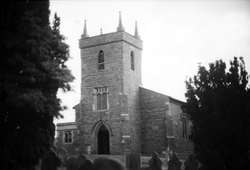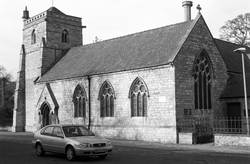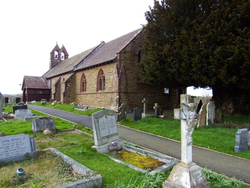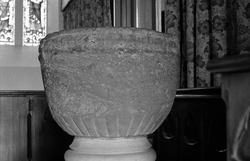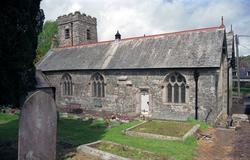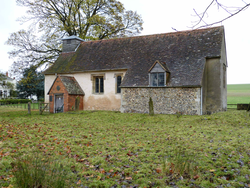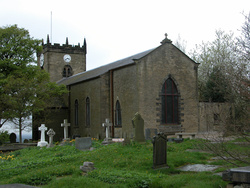
The Corpus of ROMANESQUE SCULPTURE in Britain & Ireland

St Thomas (now)
Parish church
Legsby is a small village in the West Lindsey district of L:incolnshire, 3 miles SE of Market Rasen and 13 miles NE of Lincoln. The church is in the village centre and has a W tower with a N vestry, nave, and chancel. The earliest parts of the building date from the 13thc, including the chancel and tower arches and there are signs of work done in the 16thc and the upper parts of the tower are 18thc. It is built of squared sandstone rubble, and there is a 12thc font.
Chapel
Heington is a village located 4 miles SE of Lincoln. Of the medieval chapel almost nothing remains. The present building dates to 1865 when renovations by Michael Drury were made for the chapel to become a school. This replaced an earlier chapel which had been renovated by the patron Thomas Garratt in 1619. The massively broad W tower arch has Romanesque responds.
Parish church
Brompton is a village about two miles N of Northallerton, and is on the S side of Brompton Beck, a tributary of the River Wiske. The church occupies a central position in the village, adjacent to the village green. The building has 12thc origins and is of coursed squared stone and ashlars. The church comprises a continuous chancel and nave extended eastwards and westwards during the 14thc, with a N aisle, and a 15thc SW tower of three stages above the porch. Several hogback tombs, a cross shaft and other pieces of Anglo-Danish origin, of exceptional quality, have been conserved within the church. A comprehensive programme of restoration of the church was the begun in 1863. The surviving Romanesque element is the arcade in the N aisle.
Parish church
Halford is a hamlet in the Shropshire Hills, just east of Craven Arms, whose civil parish it belongs to. It is 7 miles NW of Ludlow . The church consists of a chancel and a nave with a S porch and a double bell cote over the W gable. It is 12thc in origin and was restored in 1848, followed by a major restoration in 1887 by Thomas Nicholson in which the chncel was replaced along with the W wall and the bellcote. Romanesque features surviving are the S nave doorway and the fontx.
Parish church
Hanwood is a substantial village 3½ miles SW of Shrewsbury on the A488 road to Pontesbury. It is built along this road with the church on the main road and much modern housing on new roads to either side. The civil parish is Great Hanwood, which includes also the village of Hanwood Bank at the E end of HanwoodThe church is largely of 1856 and of red brick, although the sandstone plinth is medieval and there is some 17thc and 18thc brickwork in nave and chancel. It has an unaisled nave with a polygonal chancel under the same roof; a W belfry over the nave; a N porch and vestry and organ chamber to either side of the chancel. The only Romanesque work is the font.
Parish church
Originally a chapel of ease to its mother church of St Stephen, St Thomas's church lies midway between St Stephen's and Launceston. The church is built predominantly in the Perpendicular style. The Romanesque features of the church are a large font, a tympanum and a crude figure panel.
Redundant parish church
East Shefford is effectively just East Shefford house and this church, situated less than half a mile SE of the more substantial village of Great Shefford; itself 5 miles NE of Hungerford. The church consists of a single nave and chancel of c.1100 (12thc. window in N wall, 12thc. paintings on chancel arch wall) with timber bell turret at W end of nave and S nave doorway. The chancel E wall was rebuilt 13thc., and the chancel arch enlarged and a S chancel chapel added, probably c.1463.
Regular worship at the church was discontinued in 1870, although it is still consecrated. The congregation transferred to the newly-built church of the Holy Innocents (now demolished). Plans to demolish St Thomas's in 1958 were halted by the Friends of Friendless Churches. In 1972 the church was taken over by the Redundant Churches Fund, renamed The Churches Conservation Trust in 1994. Romanesque sculpture comprises a font, a pillar piscina and a loose fragment elaborately carved with foliage.
Parish church, formerly chapel
Mellor stands in the High Peak on the border with Derbyshire. Indeed it was in Derbyshire until 1936 when it was reassigned, along with neighbouring Ludworth, to Cheshire. Recent excavations have disclosed an Iron Age hill fort alongside the church. St Thomas's was formerly a chapel of ease to Glossop in Derbyshire, and remains in the Glossop Deanery of the Diocese of Derby. The church has a 15thc. W tower, but whatever was to the east of this was replaced from 1815 to 1830 with a simple aisleless nave and chancel of brick. Something similar took place at Church Lawton. The only Romanesque feature is the font, one of the most interesting in the county.
